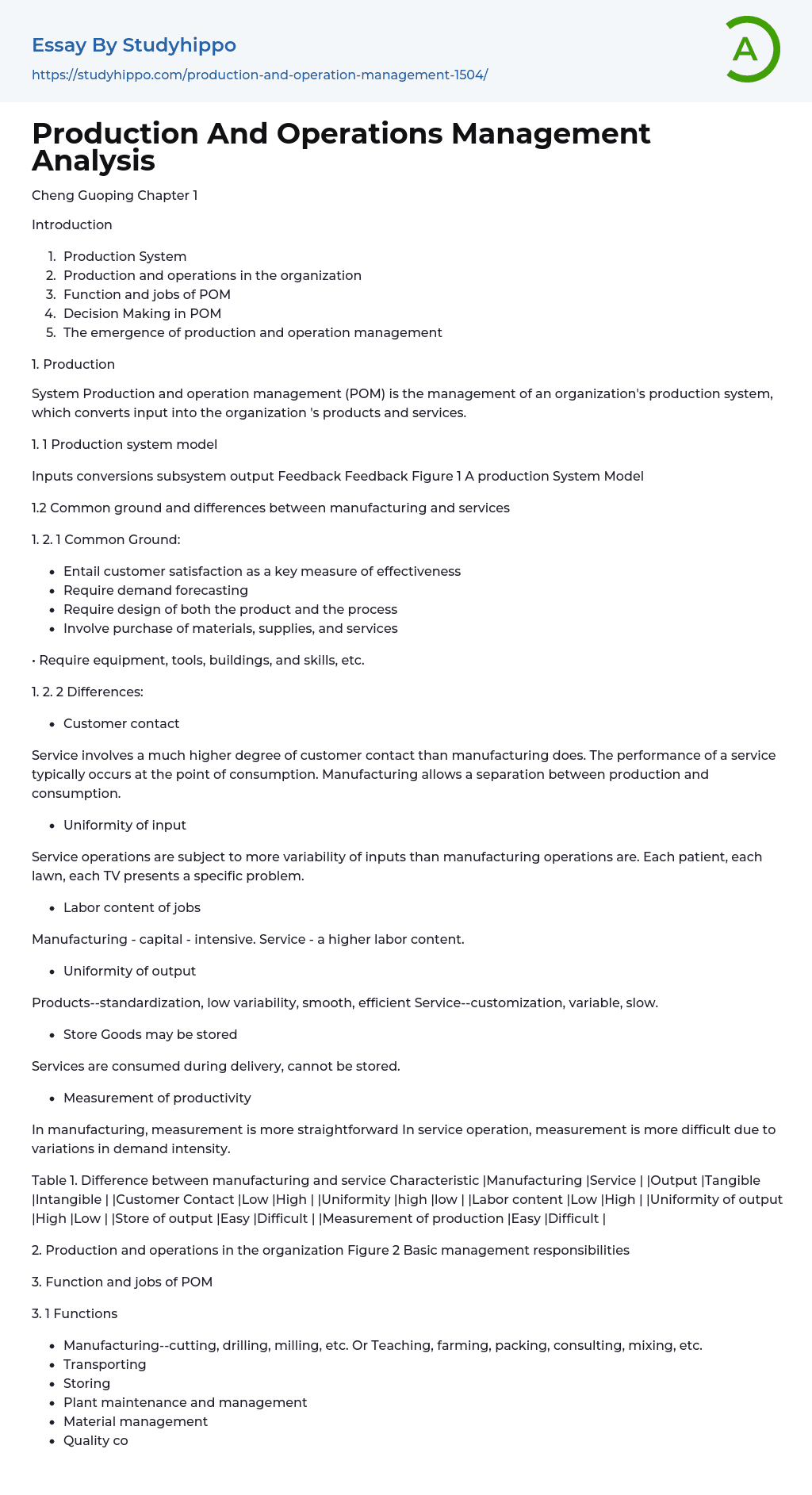Cheng Guoping Chapter 1
Introduction
- Production System
- Production and operations in the organization
- Function and jobs of POM
- Decision Making in POM
- The emergence of production and operation management
1. Production
System Production and operation management (POM) is the management of an organization's production system, which converts input into the organization 's products and services.
1. 1 Production system model
Inputs conversions subsystem output Feedback Feedback Figure 1 A production System Model
1.2 Common ground and differences between manufacturing and services
1. 2. 1 Common Ground:
- Entail customer satisfaction as a key measure of effectiveness
- Require demand forecasting
- Require design of both the product and the process
- Involve purchase of materials, supplies, and services
• Require equipment, tools, buildings, and skills, etc.
1. 2. 2 Differences:
- Customer contact
Service involves a much higher degree of customer contact than man
...ufacturing does. The performance of a service typically occurs at the point of consumption. Manufacturing allows a separation between production and consumption.
- Uniformity of input
Service operations are subject to more variability of inputs than manufacturing operations are. Each patient, each lawn, each TV presents a specific problem.
- Labor content of jobs
Manufacturing - capital - intensive. Service - a higher labor content.
- Uniformity of output
Products--standardization, low variability, smooth, efficient Service--customization, variable, slow.
- Store Goods may be stored
Services are consumed during delivery, cannot be stored.
- Measurement of productivity
In manufacturing, measurement is more straightforward In service operation, measurement is more difficult due to variations in demand intensity.
Table 1. Difference between manufacturing and service Characteristic |Manufacturing |Service | |Output |Tangible |Intangible | |Customer Contact |Low |High | |Uniformity |high |low | |Labor content |Low |High | |Uniformity of output |High |Low | |Store of output |Easy |Difficult | |Measurement of production |Easy
|Difficult |
2. Production and operations in the organization Figure 2 Basic management responsibilities
3. Function and jobs of POM
3. 1 Functions
- Manufacturing--cutting, drilling, milling, etc. Or Teaching, farming, packing, consulting, mixing, etc.
- Transporting
- Storing
- Plant maintenance and management
- Material management
- Quality control, etc.
4. Decision Making in POM
4. 1 Strategic Decision ----Being of strategic importance, having long-term significance
• Deciding whether to launch a new-product development project
• Deciding on the design for a production process for a new product
• Deciding what new factories are needed and where to locate them
• How to allocate scarce raw materials, utilities, capacity, personal among new and existing business opportunities
4.2.Operation decision ---- Planning production to meet demand
- Deciding how much finished-goods inventory to carry for each product
- Deciding what products and how much of each to include in next month's production schedule
- Deciding whether to increase production capacity next month by overtime or subcontract
- Deciding the details of a plan for purchasing raw materials
4.3. Control decision ----Planning and scheduling operations
- Deciding quality control criteria
- Deciding time arrangement
- Day-to-day decision about workers, product quality, machinery
4.5. The emergence of production and operation management
External Legal/political Social Economic Technological Market Competition Product Information Customer Desires Resources People Materials Energy Capital Equipment Facilities Technology Conversion Subsystem Direct Outputs Products Services Indirect Outputs Taxes Wages and salaries Technological Development Employee Impact Environment Impacts Social Impact Control Subsystem Marketing Production Finance Maintenance POM Public relations Personnel Industrial engineering Purchasing Accounting
- Chief Executive Officer essays
- Convenience Store essays
- Firm essays
- Training And Development essays
- Unilever essays
- Variable Cost essays
- Virgin Group essays
- Bargaining essays
- Entity essays
- Pest analysis essays
- John Locke essays
- 9/11 essays
- A Good Teacher essays
- A Healthy Diet essays
- A Modest Proposal essays
- A&P essays
- Academic Achievement essays
- Achievement essays
- Achieving goals essays
- Admission essays
- Advantages And Disadvantages Of Internet essays
- Alcoholic drinks essays
- Ammonia essays
- Analytical essays
- Ancient Olympic Games essays
- APA essays
- Arabian Peninsula essays
- Argument essays
- Argumentative essays
- Art essays
- Atlantic Ocean essays
- Auto-ethnography essays
- Autobiography essays
- Ballad essays
- Batman essays
- Binge Eating essays
- Black Power Movement essays
- Blogger essays
- Body Mass Index essays
- Book I Want a Wife essays
- Boycott essays
- Breastfeeding essays
- Bulimia Nervosa essays
- Business essays
- Business Process essays
- Canterbury essays
- Carbonate essays
- Catalina de Erauso essays
- Cause and Effect essays
- Cesar Chavez essays




